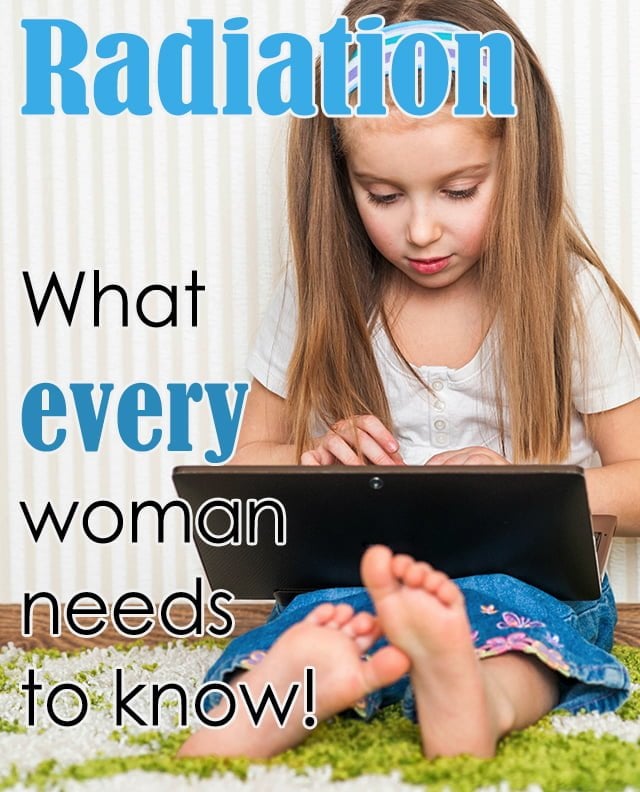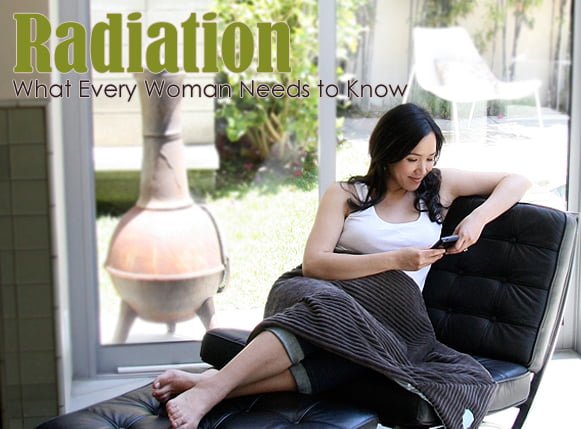Radiation: What Every Woman Needs to Know
 If you were pregnant, would you consider stripping lead-based paint without a respirator, breathing chloroform, or working in a garage full of engine exhaust?
If you were pregnant, would you consider stripping lead-based paint without a respirator, breathing chloroform, or working in a garage full of engine exhaust?
Of course not. It’s widely known that these substances can cause cancer and other health problems, and could potentially harm your growing baby.
But every day, millions of pregnant women – and their unborn babies – are exposed to a substance recognized by the World Health Organization as carrying the same risk level for cancer as chloroform, gasoline fumes, and lead. It’s a substance you can’t see, hear or feel, but it’s present almost anywhere you go. In fact, you’re almost certainly being exposed to it right now as you read these words.
This “substance” is not actually matter. It’s a type of energy known as non-ionizing radiation. And recent research indicates that it’s a cause for concern – especially for pregnant women and young children.
Radiation: a growing concern
Radiation isn’t always dangerous. Most of the radiation we receive is naturally present in the environment. Some is actually beneficial: heat and light are both forms of radiation necessary to support life. However, our average annual radiation exposure is increasing dramatically – 172% between 1996 and 2006, according to the National Council on Radiation Protection and Measurement. Much of this excess radiation exposure occurs at home, in the workplace, and even in the doctor’s office. And some forms of it can significantly impact our health, and the health of our unborn children.
Fetuses and young children are especially susceptible to the effects of radiation. Their immune systems are immature, and the rapidly growing and dividing cells in their developing tissues and organs are more readily disrupted than those of an adult. Radiation exposure has been linked to a wide variety of ill effects in children, including delayed growth, small head size, mental retardation, nervous system damage, behavioral problems, and cancer.
In order to assess the risks and take action to protect ourselves and our children, it’s helpful to understand the different kinds of radiation and their sources. Let’s start by taking a look at the two basic categories of radiation: ionizing and non-ionizing.
Ionizing radiation
Very simply, ionizing radiation is radiation made up of particles that carry enough energy to knock electrons off of atoms, creating different forms (ions) of the atomic elements. This is the type of radiation that makes a Geiger counter click, and that’s associated with mushroom clouds and nuclear accidents like Fukushima.
Now that the cold war is over and our medical providers are well versed in the use of lead shields to protect us from necessary x-rays, the most common type of ionizing radiation most people have to worry about is radon, a radioactive gas that tends to accumulate in homes and other buildings. The U.S. Environmental Protection Agency and the Surgeon General recommend testing all homes located on the third floor or lower for radon. It’s an especially good idea if you have – or plan to have – children. Fortunately, radon reduction systems are effective and relatively inexpensive.
Non-ionizing Radiation: The wave of the future is here.
The other major category of radiation is non-ionizing radiation, or electromagnetic fields – EMF’s for short. EMF’s are a kind of radiation that exhibits wave-like behavior, carrying energy through space away from the source. These waves have both electric and magnetic properties, and aren’t normally energized enough to detach electrons from atoms and molecules. Non-ionizing radiation includes heat, visible and invisible light, microwaves, radio waves, and Very Low Frequency (VLF) and Extremely Low Frequency (ELF) radio waves.
In the modern world, EMF’s are everywhere – and are largely responsible for our annual increase in radiation exposure. They’re emitted by cell phones, computers, Wi-Fi, microwave ovens, TV and radio towers, military installations, and – especially relevant to pregnant moms – medical imaging technology, including ultrasound.
Until recently, most experts cautiously considered most types of non-ionizing radiation to be relatively safe. However, a number of recent studies indicate that we may need to be more concerned than previously thought – especially when it comes to our beloved cell phones. Since mobile phones are used frequently and often held close to the body, they are the most widespread source of EMF exposure for most people. There is mounting evidence linking cell phone use to brain cancer, with tumors tending to appear on the side of the head nearest to where the phone is held.
Although some organizations, including the National Cancer Institute, are calling for further study, several governments are now advising caution in the use of cell phones, especially by children and pregnant women. There is evidence that heavy cell phone use places children at higher risk not only of cancer, but also of ADHD and autism. Russia,
Germany, India, Israel, Belgium, and the U.K. all discourage children’s use of mobile phones, and France has recently banned the marketing of cell phones to children.
Should pregnant women ditch their phones?
So what should you do if you’re pregnant? Get rid of your cell?
For most of us, that’s not an option. Or at least, not an option we want to hear. We need our phones for work… and… O.K., let’s face it; we’re addicted to the convenience.
Fortunately, there are ways to minimize the risk of exposure from our favorite devices. If you absolutely can’t do without your phone, Dr. Devra Davis, founder and president of the nonprofit Environmental Health Trust, ehtrust.org, recommends the following precautions:
- Keep your cell phone as far from your body as possible during use. Put it on speaker phone, or use a wired headset. Texting is also fine!
- Avoid carrying your phone on your body. If you can’t avoid it, then make sure the back of the phone is facing away from you. Better yet, turn it off or put it on airplane mode. And don’t carry the phone in your bra – there have been reported cases of cell-phone induced breast cancer in women who do.
- Limit the length of your cell calls. Reserve your phone for quick communications, and switch to a landline for longer calls.
- When possible, text instead of calling.
- If you have to hold the phone to your head, switch sides frequently.
- Avoid using your phone in a moving vehicle, or where the signal is weak, since it works harder and emits more EMF’s in these situations.
- Choose a “safer” phone. The Specific Absorption Rate (SAR) is a measure of the amount of energy absorbed by the body when using a particular phone. A lower SAR indicates less radiation. For more information, visit the Federal Communications Commission’s SAR page.
- If you are pregnant, invest in a radiation barrier. In south Asia when a woman is pregnant she is immediately given a pregnancy smock. In the U.S., you can purchase one for yourself. One popular brand is Belly Armor.
The Environmental Health Trust offers free information and printable posters, cards and infographics you can use to help spread the word about cell phone safety to schools, doctors, and friends. You can find them atwww.ehtrust.org/resources/.
What about ultrasound?
Ultrasound imaging has become a routine and, for many expectant moms, enjoyable part of pregnancy. Doctors use it to make sure the pregnancy is progressing normally, and moms look forward to the first fuzzy pictures of their babies with the same excited anticipation as they do the first little kicks. But ultrasound is a type of EMF, just like cell phone radiation. Is it really as safe as we think?
Dr. Davis recommends moderation. “It’s really important that the person doing the ultrasound be a specialist in pregnancy, because you want to minimize radiation,” she says. “In Finland, they do just one in the 11th or 12th
week, and offer one more optional one later in the pregnancy. I think that’s sensible. I am concerned about the overuse of ultrasound in pregnancy. The idea that you need to do an ultrasound at every visit, or that the ultrasound has to be done throughout the pregnancy is really questionable. And I am appalled at the commercialization, where you get the 3D imaging in shopping centers. I think this is grotesque and a really bad idea. Like a lot of things we’re doing in technology we are overdoing it.”
Can Wi-Fi harm your baby?
What about all the other sources of EMF’s out there? Does sitting in Starbucks pose a hidden menace to your unborn child?
Unfortunately, that’s a question we may never know the answer to. Practically speaking, we all now live in a sea of radiation that has never existed before. And there’s really no way to test its effects, because we don’t have a control group of people who are living a similar lifestyle without the radiation.
With that in mind, it’s a good idea to err on the side of caution and limit exposure to wireless radiation as much as possible. For instance, we can use landlines and standard internet connections at home, and reduce our contact with the highest exposure devices: cell phones, cordless phones, phone base stations, and the backs of computer monitors (so if you work in an office try to avoid sitting against the back of your colleague’s computer screen.)
Time and distance matter
One important point to remember is that wireless exposure is an inverse square law. This means that being twice as far away results in four times less exposure. That’s why moving a short distance from the source (like using your phone on speaker setting instead of holding it to your ear) can make a dramatic difference in the amount of radiation you receive.
When using laptops and similar devices, understand that they’re not approved for use next to the body. Laptops are tested to be safe at a distance of 8 inches. So while your pregnant belly may make a beautiful table, save it for a bowl of popcorn or a paperback. Or, put your Kindle on airplane mode once you’ve downloaded your e-book.
Another thing to be aware of when you’re pregnant is timing. The most sensitive period for your baby is between the 8th and 15th weeks of pregnancy. That’s when her brain and nervous system are developing and growing at the most rapid rate. You’ll want to be especially careful to protect her during these weeks.
They’re phones, not bombs
But while it’s important to be prudent, there’s no need to panic.
“Don’t worry,” says Dr. Davis. “Babies have a way of getting what they need.”
Her top recommendations?
“Make sure you sleep in the dark. That will let your body make sufficient amounts of melatonin, which helps fight radiation. Eat your broccoli. The general emphasis on nutrition is wonderful. That, and practice safe phones.”
Good advice for anybody.
Additional Resources:
http://microwavenews.com/aitken.html
http://cmch.tv/mentors/hotTopic.asp?id=70
http://pediatrics.aappublications.org/content/128/5/1040.full
http://www.ncbi.nlm.nih.gov/pubmed/17409179
http://ehtrust.org/downloads/
By Anne Michelsen, a former La Leche League Leader and bemused mother of two delightfully unconventional teenagers. As a freelance copywriter, she helps ethical and sustainable companies promote their products, and enjoys writing the occasional article on environmental issues.
This article is a special feature in the Winter 2013 issue of Green Child Magazine.



I know this doesn't really have anything to do with radiation, but yes it does because it shows how slow government agencies is in regulating dangers; Lead Based Paint, etc. http://beautifulnightmare-killumbus.blogspot.com/2013/06/wtf-usda-says-to-label-meat-tenderized.html
ReplyDelete